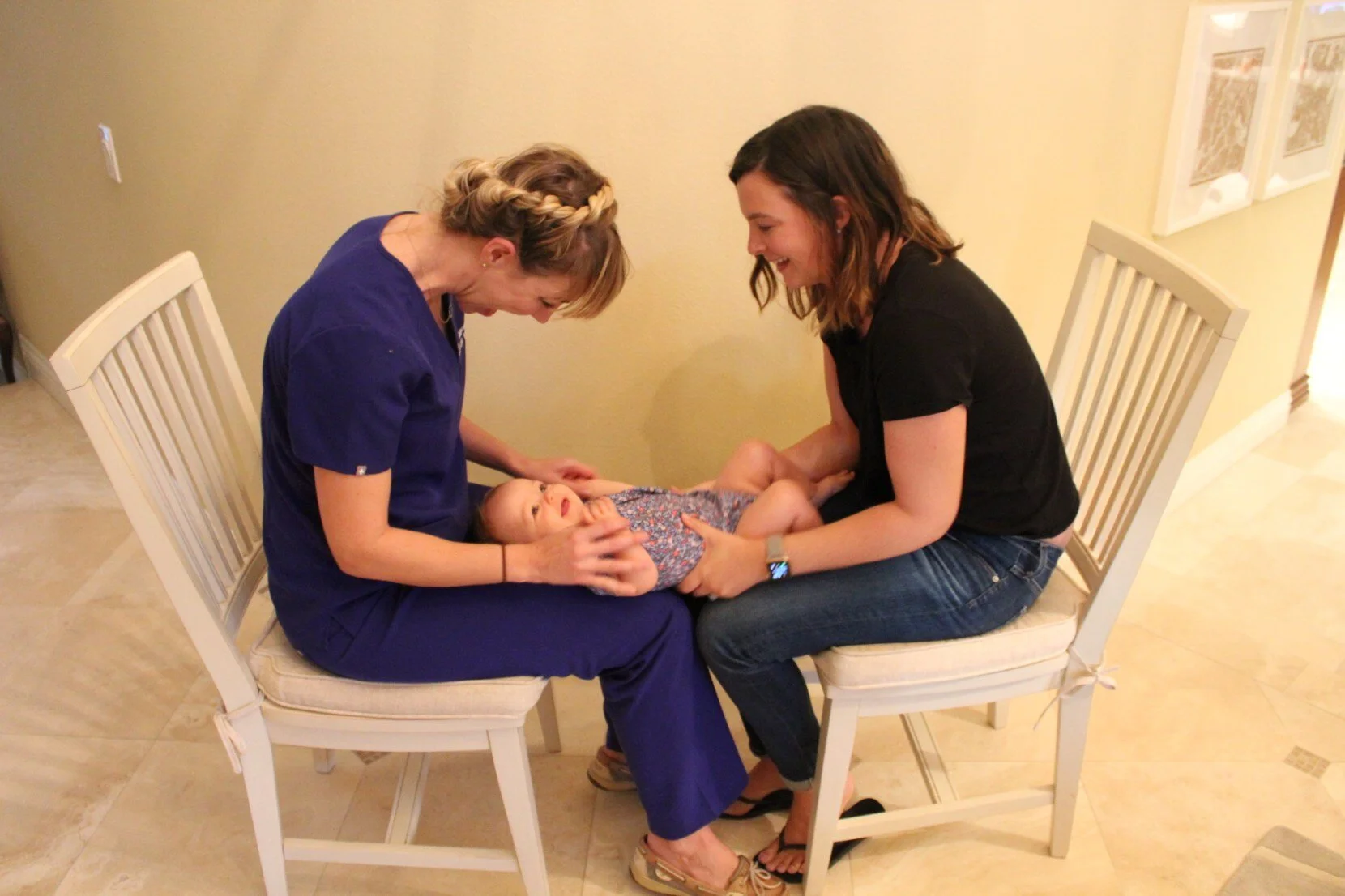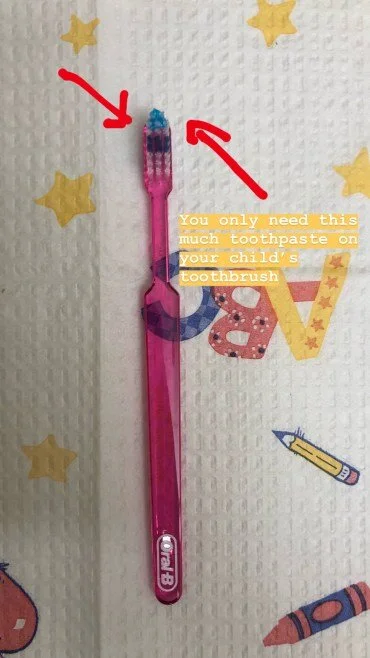What to Expect at Your Child’s First Dental Appointment
“Mommy, do we have to go to the hospital?”
As a pediatric dentist, I often times find myself talking to friends with children and answering a lot of common questions about when they should take their child to the dentist and what to expect when they do.
The official stance from the American Academy of Pediatric Dentistry is that most children should be seen by their dentist either by age 1 or when they get their first tooth – whichever comes first. Do dentists really expect 1 year olds to already have cavities?! The answer, thankfully, is no! However, just as parents take their babies and toddlers to the pediatrician for well baby check-ups to monitor the child’s health, get some preventive vaccinations, and to better understand what to expect next in their baby’s development, so do pediatric dentists love the opportunity to educate the parents about preventive measures to take before it’s too late. It also lets us make sure that your baby’s mouth is progressing normally!
Finding the right pediatric dentist for your child is a great first step to helping shape their attitudes about going to the dentist.
Many parents may think that they don’t need to bring their children in until age 4 or 5 because “they’re just baby teeth” but you would be shocked at how many 4 or 5 year-olds I see every day who have multiple cavities by the time they come to the dentist for the first time. But here are a few more great reasons for early visits.
It allows you time to establish yourself and your child with your dentist. We dentists call this establishing a “dental home”. I’m biased (obviously) but by selecting a pediatric dentist, you are taking your child to a dental provider who not only has their dental degree, but two additional years of training in pediatrics, including child behavioral psychology, growth and development, and many other child-specific issues. This is not to say there aren’t phenomenal general dentists who also can see your child, but many general dentists aren’t comfortable seeing children at such a young age. When you start bringing your child in early, you can have them begin to get familiar with the office and what to expect. And should your toddler take a tumble and injure their mouth, you have a pediatric dental provider who is available to you!
During a new patient visit, there are 3 topics of conversation that we will discuss before starting the exam. 1. The child’s overall health history 2. Nutrition and 3. Anticipatory Guidance. I’ll explain more below.
Health History
You may not think it’s important to tell your dentist about your child’s health history, but it’s very important for us as health care providers to get a good sense of your child’s overall health. Have they had any surgeries? Allergies? Asthma? Hospitalizations? Medications? These are all things that we as dentists need to know as they inform us how to best treat your child and what treatment options we can make available to them.
Nutrition
1: Is your child breastfeeding throughout the night or going to bed with a bottle?
Most people think that breastfeeding, being so natural, can have no bad effects on an infant. Unfortunately, this is not true when it comes to the teeth. After children start to have multiple teeth, continuously
breastfeeding throughout the night or drinking from a bottle
throughout the night can cause cavities on the child’s front teeth. Allowing milk to sit on the teeth continuously throughout the night causes the enamel (outer layer of the teeth) to soften, leading to cavities. You might even start to notice these cavities when you look at your child’s upper front teeth. The softening starts by looking like white spots, usually around the gum line. For bottle feeding we normally see the white spots on the front of the teeth, but for breastfeeding, the white spots normally start on the back side of front teeth. This is due to the placement of the tongue when suckling.
This child has cavities on all their front teeth
I know that you have to pick your battles as a parent, but trying to wean your child to only water at night by age 1 will help prevent cavities in the future. At the very minimum, if it is impossible for your child to go through the night without feeding, wiping their teeth with a damp, wet cloth will also help wipe off the milk and sugar that would otherwise stay on the teeth.
2. How much liquid is your child drinking other than milk or water?
Again this is not necessarily about how much sugar is in the drinks that your child is drinking, but about the frequency in which they are sipping on these drinks throughout the day. The recommended amount of juice for children per day is 4 oz, aka one child-size cup. This should be given with a meal and in a cup, not a sippy cup, so that the child is not sipping on sugary drinks throughout the day. Even watering down juice (which is preferred) will still not prevent cavities if the child is drinking it throughout the day.
Only 4 oz of whole fruit juice is recommended per day and with a meal is preferred.
Anticipatory Guidance
Anticipatory guidance is just a fancy way of saying, “As a parent, what can I anticipate is going to happen with my child’s mouth over the next few months, and what should I be doing about it?” Here are the most common things that we discuss with parents.
Trauma
We’ve all seen those YouTube videos comparing toddlers learning how to walk with drunk people. Because these little ones aren’t too steady on their feet, falling and hitting their teeth is relatively common.
I like to tell parents that if their child falls and has any kind of trauma to their mouth to make an appointment to come in and see their pediatric dentist. The most common types of injuries are called subluxations – which means that the teeth can be knocked loose temporarily. Depending on the extent of trauma and how loose the teeth are, baby teeth can tighten back up and be just fine. The most common side effect of trauma for baby teeth is the teeth affected turning either a dark gray or dark yellow color. This color change does not necessarily mean that the tooth is infected or needs to come out, think of it more like a bruise. Either way, it’s always a good idea to be seen by your pediatric dentist so they can follow your child’s healing progress.
Sometimes a tooth will turn a darker color but then may return to its original color after a few months.
Sometimes with trauma, the teeth are knocked loose or cracked in half and are not savable. This requires a dentist to take out the affected teeth. Many parents are very sad to have their child lose a tooth before it’s ready to fall out, but please know that if this is you, it’s something that is often seen and most children do just fine missing a tooth or two.
Thumb sucking/ Pacifiers
Thumb-sucking or pacifier use is very common in children, and a lot of parents want to know when they should consider weaning their child off of it. The considerations for this should be time and frequency. If your child is always sucking their thumb and is doing it for long periods of time, it can cause the roof of their mouth to change shape and can also cause their upper front teeth to flare out. Most children stop these habits on their own, but if they are three or older and still haven’t kicked the habit – talk to your dentist about possible solutions. Some children will suck fingers, thumbs and pacifiers for several years with no effect at all on their bite, while other children may have the habit for only a year or two and it will create noticeable changes in their overbite, and bite in general.
Teeth Grinding
This is another question that I get asked about all the time. “My child grinds their teeth at night – do we need a mouth guard?”
Here’s what I tell parents with regards to grinding. It is very common in young children, and although we don’t know specifically why children grind their teeth, experts think it may have to do with tonsil or adenoid size. Many children have large tonsils, so when they sleep it can partially block their airway. Grinding your teeth actually moves your jaw forward, allowing your airway to be more open. However, this is just a theory as there are children who have their tonsils and adenoids removed and still grind. Another theory is that it is a sleep disturbance, similar to talking in your sleep, or bed wetting. As most children outgrow these habits, they tend to outgrow grinding as well.
As pediatric dentists, we don’t prescribe mouth guards for grinding because 1. It would be a choking hazard for children while they sleep. 2. Even though children can grind their teeth down significantly, it rarely ever causes tooth sensitivity or abscess.
Exam/Cleaning/Fluoride Varnish
After I’ve talked through all of the above with parents, we typically do an exam. Most children under the age of 3 will not sit in a normal dental chair (although some will) so we opt to do what’s called a knee-to-knee exam. This requires you to hold your child facing you and to lean his head back in your dentist’s lap.
An example of the knee-to-knee position.
For the exam, I normally brush and floss the child’s teeth with a regular toothbrush. You might think to yourself, “Well, I can brush my child’s teeth at home – why am I paying my dentist to do it?” What I’m checking for as I brush is your child’s gum health, as well as how clean his teeth are (aka how good of a job are you doing with brushing at home?). Also, I’m usually giving parental instructions on the best and easiest ways to brush a 2 year old’s teeth, who does not want his/her teeth brushed. Sometimes when I brush, the child’s gums will bleed a little. This is not something to be alarmed about – it is normally either because your child has gingivitis (mild inflammation) and needs to brush better at home, or sometimes the gums tend to be more inflamed if new teeth are growing in.
This is most likely what your dentist will use at your child’s first dental appointment
(for children under the age of 3)
When I brush your child’s teeth, I use a rice-grain-sized amount of toothpaste. It’s basically the smallest amount you can put on a brush. We also like parents of toddlers to use infant toothpaste which is fluoride-free, because toddlers are not usually capable of spitting, and they do not need that much fluoride at this stage. If you don’t have any non-fluoridated toothpaste, you can simply brush without toothpaste. The most important part is the mechanical removal of all the food eaten in the day and the dental plaque which forms during the day (and night).
You only need a rice-grain amount of toothpaste
After tooth brushing I will take a mirror and look at your child’s teeth, gum tissues, tongue and lips. This normally takes about 30 seconds. I finish off the exam by putting topical fluoride on the erupted teeth. Topical fluoride varnish is different from the fluoride toothpaste. Although it is a higher concentration of fluoride, it is only put on the teeth 2x per year instead of having fluoride toothpaste every day.
The amount of time it takes for me to do the cleaning, exam and fluoride varnish is about 3 minutes. During this time, it is normal for your child to cry. Many children experience “stranger danger” at this age – and this is all the more reason to be faithful about bringing your child to the dentist every 6 months so they can get used to coming. Your child may cry during the exam, but they typically recover very quickly as soon as the exam is done. Children also do not form lasting memories until around 3, so even if it seems like a difficult experience for them, the memory won’t last. Also, please remember that children less than 2 years of age have very limited vocabularies, therefore much of their communication is done by crying. A crying child does not necessarily mean a scared child or a hurt child! It can mean “I don’t like this”, “I’m tired and need a nap”, “When can I go back to playing?”, or any number of things.
Other Takeaways for First-Timers
You, the parent or caregiver, are the single most important factor on your child’s view of the dentist. I have had many parents say to their children when I am seeing them for an exam, “You better behave or the dentist will pull out your teeth!” or “You better behave or the dentist will give you a shot.”
These phrases can be really psychologically damaging to a child’s attitudes about the dentist. First of all, sometimes I do have to give children a “shot” (although I like to call it “tooth sleepy juice”) or take out infected teeth. My job as a dentist is to make the experience as safe, pleasant, comfortable and quick as I can, but at the end of the day certain aspects of going to the dentist aren’t pleasant, and trying to threaten a child, or anticipate what the dentist might do is generally counter-productive.
You as a parent can really help your child to be brave and to do well at the dentist by avoiding words like “hurt” and “shot”, and instead use phrasing like “the dentist is going to help your teeth feel better.”
This awesome article (click here to read) explains what you can do to help create positive attitudes for your child about going to the dentist. Because at the end of the day, if your child has cavities that need to be fixed, wouldn’t you rather have it be something they can do without it being a big ordeal? The main takeaways from the article are that a child’s attitudes about the dentist start with you, the parent.
Also, this is why we start kids visiting the dentist early! If they start going when they’re young, they will begin to know what to expect. Plus, chances are the dental office has a toy box where they can pick out a toy afterwards.
Set your child up for success. Make their first dental appointments early, find a dentist that you really like, and make your child’s oral health a priority.
A successful first visit to the dentist!









